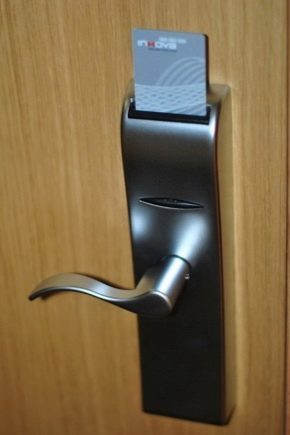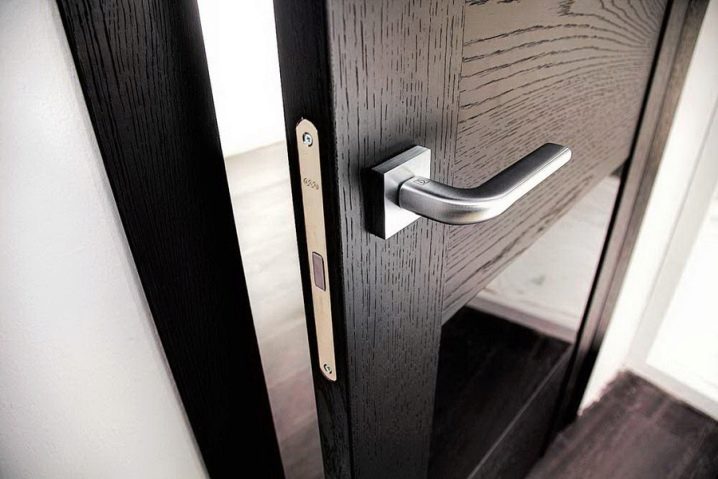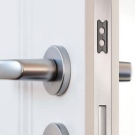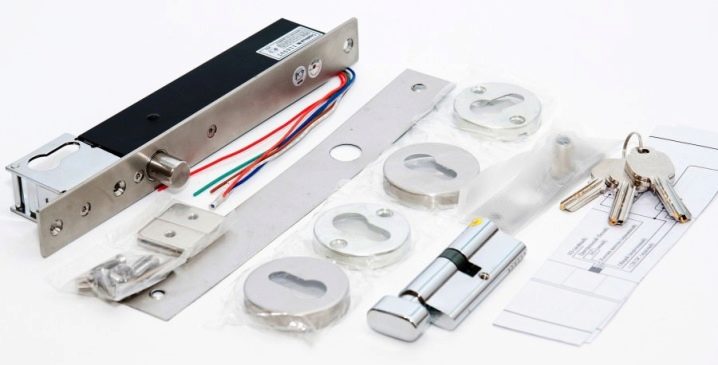Magnetic door locks: selection, principle of operation and installation

In the 21st century, electronics are replacing mechanics in almost all spheres of human activity, including locking devices for entrance and interior doors. Almost every entrance in large cities today is equipped with an intercom with an electromagnetic lock, and in office centers magnetic locks are common on interior doors, which make it possible to restrict the access of different categories of personnel to different rooms. Therefore, it is worthwhile to figure out what is the principle of operation of magnetic locks on the door, how they are installed, how to make the right choice of such a device.

Application area
Magnetic constipation is now common in both households and commercial buildings and government offices. It is these locks that are installed on the entrance doors of the entrances together with intercoms so that residents can open them remotely. In office centers, the installation of such locks allows you to give different employees access to different rooms - an access card can open only one lock or several at once. At the same time, in the event of an employee's dismissal, it is not even necessary to take the key from him - it is enough to change the access signature and update the cards from the remaining employees.






Finally, in government agencies, such locks are installed on premises in which especially valuable items or documentation are stored, since these devices are usually much more reliable than mechanical ones. At the entrance doors of individual apartments and private houses (with the exception of elite cottages), magnetic locks are so far installed extremely rarely. There are almost no electromagnetic locks on the interior doors of residential buildings. But simple magnetic latches in such cases have been widely used since Soviet times.




Operating principle
And for serious electromagnetic devices with cards or keys, and for primitive latches, the principle of operation is based on the mutual attraction of parts with different magnetic charges. In the case of a latch, two permanent magnets are sufficient, oriented so that their opposite poles are opposite each other. The action of electromagnetic locks is based on the appearance of a magnetic field around a conductor through which an alternating electric current flows.

If you give the conductor the shape of a coil, and put a piece of ferromagnetic material (which is usually called a core) inside it, then the magnetic field created by such a device will be comparable to the characteristics of powerful natural magnets. A working electromagnet, like a permanent one, will attract ferromagnetic materials, including most common steels. Expressed in kilograms of effort required to open the doors, this force can range from several tens of kilograms to one ton.

Most modern magnetic locks are an electromagnet with a control system and a so-called counter plate, usually made of steel. When closed, an electric current flows continuously through the system. To open such a lock, you need to temporarily stop the supply of current to it. This is achieved using a control system, which usually includes a special reader that receives data from a magnetic key, tablet or plastic card and compares it with those recorded in its own internal memory. If the signatures match, the control unit cuts off the current, and the force holding the door disappears.

Often, such systems include additional elements, the most common of which is a pneumatic door closer that gradually returns the door to a closed state.Sometimes there are combined variations of magnetic locks with mechanical locks, in which the forces of magnetism are used to hold a movable part (known as a deadbolt) inside its corresponding groove. These designs are devoid of the advantages of electromagnetic and represent an advanced version of the latch, therefore, they are used only for interior doors in homes and offices.

Varieties
As mentioned above, according to the principle of operation, magnetic locks are divided into:
- electromagnetic;
- using permanent magnets.


In turn, according to the method of opening, the electronic magnetic lock on the door can be:
- by keys;
- by tablets (a kind of magnetic keys);
- by card (the signature is written on a plastic card, which is read by a special device);
- code (the control device includes a keyboard, providing for the possibility of entering a code);
- combined (these are on most intercoms, the door can be opened both by entering a code or using a tablet).




Moreover, if in most cases the data of a key, tablet or code is compared with data from the internal memory of the device, then models with access by card are usually connected to centralized control systems. In this case, each card has its own code that uniquely identifies its owner. When the card is read, this information is transmitted to a central server, which compares the cardholder's access rights with the security level of the door he is trying to open and decides whether to open the door, leave it closed, or even raise an alarm.

Permanent magnet locks are opened in any case by mechanical disconnection of the two parts. In this case, the applied force must exceed the force of magnetic attraction. While conventional latches are easily opened with the help of human muscle strength, in the case of combined mechano-magnetic locks, opening systems using force-increasing levers are sometimes used. According to the method of installation, the door magnetic lock can be:
- overhead when it is attached to the outer part of the door leaf and the outer part of the door frame;
- mortise, when both of its parts are hidden inside the canvas and box;
- semi-recessed, when some of the structural elements are inside, and some are outside.

Magnetic latches and combination locks are available in all three variations. With electromagnetic locks, everything is a little more complicated - the options installed on the entrance doors are usually only overhead, but for interior doors, along with overhead, there are also semi-cut structures.
Advantages and disadvantages
All magnetic locking systems have common advantages:
- the minimum number of moving elements (especially the absence of a locking spring) significantly increases the durability of the lock;
- minimal external wear during operation;
- ease of closure;
- the doors are closed and opened almost silently.

Electromagnetic options additionally have the following advantages:
- the ability to integrate with centralized security and surveillance systems;
- making copies of a magnetic key is much more difficult and expensive than for a conventional key, which reduces the risk of intrusion by strangers;
- huge locking force, far exceeding the capabilities of most mechanical systems;
- due to the large dimensions of the counter plate, the occurrence of skewing of the doors during operation almost does not reduce the effectiveness of the locking.

The main disadvantages of electronic systems:
- some older intercom systems with a combination lock have a universal service access code that can be known to intruders;
- for the stable operation of the system, a constant power supply is needed, since without the flow of current the door will be in an open state;
- the complexity of installation and maintenance (change of access signature, repair, etc.);
- reliable electronic constipation is still much more expensive than a mechanical counterpart.

Permanent magnet systems have the following advantages:
- work without a power source;
- ease of installation.

The main disadvantage of such devices is their low holding force, which limits their use exclusively with interior doors.
Device complete set
The scope of delivery of the electromagnetic locking system most often include:
- electromagnet;
- mating plate made of steel or other ferromagnetic material;
- control system;
- a set of accessories for installing the system;
- wires and other switching devices.

Depending on the type of device, they are additionally supplied with the following opening means:
- with a card or a set of them;
- with pills;
- with keys;
- even a set with a remote control is possible.

Optionally, the delivery set may include:
- pneumatic closer;
- an uninterruptible power supply that provides temporary operation of the system without external power supply;
- intercom;
- an external interface controller providing integration with the security system.

A set of magnetic latches usually includes:
- two latch elements installed on the door and box;
- fasteners (usually screws).

Combined mechano-magnetic locks are supplied in the following set:
- a lock with a lever (bolt);
- a counterpart with a hole corresponding to the crossbar, installed in the box;
- fasteners and accessories.

Additionally, these devices can be equipped with:
- handle;
- clamps;
- magnetic card and its reading system.

Selection Tips
When choosing a type of magnetic lock, you should decide for which room you want to use it. For the doors between the rooms of the apartment, there will be enough primitive latches or mechano-magnetic locks, for the entrance doors of the entrance it is better to use an electromagnet with a tablet and an intercom, for garage or shed doors the option with a remote control is ideal.

For office centers, a system with electromagnetic locks, cards and centralized control is practically uncontested - otherwise, you will have to give each employee a set of separate keys. When choosing an electromagnetic device, take into account the locking force - installing a lock with an opening force of a hundred kilograms on a thin door can lead to its deformation or even breakage. On the contrary, a weak magnet is unlikely to hold a massive metal door.
- for interior and exterior doors, a force of up to 300 kg is enough;
- locks with a force of up to 500 kg are suitable for entrance doors;
- for armored and simply massive iron doors, locks with "tear-off" up to a ton are suitable.

Subtleties of installation
Putting a magnetic latch on a wooden door is quite simple - you just need to mark the canvas and the box and attach both parts with self-tapping screws. Combi-locks are installed as usual mechanical locks. But it is better to entrust the installation of electromagnetic systems to professionals. To install a magnetic lock on a glass door, you need to purchase special fasteners, which usually have a U-shape. It is installed without drilling the glass sheet - it is firmly held by a system of screws, clamps and softening pads.

For information on how to install a magnetic door lock, see the next video.













The comment was sent successfully.